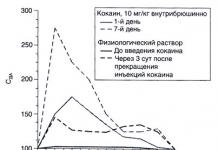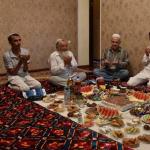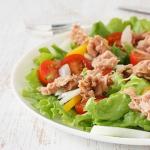Brick is a porous material. This means that it absorbs water. Those who have ever laid brick know that if the mortar is thick, then it sets slowly, and the quality of the masonry itself deteriorates, since the brick takes water from the mortar, which is already in short supply. There is also no reason to make the solution too liquid, since in this case the masonry loses its quality. In addition, the thickness of the seams will be no more than 4-5 mm, as a result of which the construction of walls will become more complicated.
What should I do? Maybe just before laying the brick, pour water over it, that is, wet it?
The answer is clear: yes, the brick needs to be wetted.

- the brick will not take water from the mortar, which is so necessary for its setting;
- the solution will not “burn”, which will lead to its saving;
- the quality of the masonry will be at the proper level;
- the seams will not have a thickness of 20-25 mm and 4-5 mm, but will become optimal for masonry, that is, 10-12 mm;
- the masonry itself will be more durable, and the wall will be less sensitive to natural phenomena such as wind, rain and snow.
Of course, different bricks have different degrees of water absorption, so it is also advisable to take this factor into account when wetting the brick.
Stoves are quite common today, even though there are more modern heating systems available. For a bath or sauna, to provide additional heating in the house, brick stoves remain indispensable. Such a stove can be built from red or fireclay bricks, but fireclay brick itself is too expensive and is rarely used for stove bodies. Most often, the masonry is made from red stove bricks, and fireclay is used for the firebox. The result is excellent quality at optimal financial costs.
Fireclay brick is frost-resistant and can withstand temperatures up to 1500 degrees.
The laying of the stove itself is carried out in compliance with the order, i.e., a special layout for each row. The diagram shows how much material is used and in what order the individual bricks and other elements of the future furnace will be arranged. To begin masonry work, you must first decide what the stove structure will be. Today 3 types are used:
- A heating and cooking stove is the best option, which is suitable for ensuring a comfortable temperature in the house and for cooking. Special compartments for baking bread are popular, but bricks should be chosen carefully; fireclay cannot be used, since when heated it releases chemicals, and this is unacceptable when cooking.
- Conventional cooking stoves are intended only for cooking, boiling cabbage soup, and drying fruit.
- Heating stoves and fireplaces are designed to heat a certain area or room.
There are separate heaters for baths; the process of laying them differs from conventional stoves. It is necessary to install a special grate for stones and a container for heating water. The stove itself must be durable and resistant to temperature changes.
Brick options for laying stoves

Kiln bricks come in different types. When choosing one option or another, it is important to take into account the necessary characteristics and future operating conditions. Among these types of bricks, there are not only special fireproof ones, but also fireclay ones. Most often used:
- Borovichi brick. It is dense and has high frost resistance. The red brick has 3 working surfaces, slightly rounded edges, which makes the block attractive. After construction, such a stove can no longer be lined.
- Vitebsk red brick has a lower density and its frost resistance is minimal. There are 2 working surfaces, the edges of the block are sharp. It is used for laying stoves, as it has the necessary properties, and its price is optimal. Block sizes may vary slightly. This must be taken into account when performing work.
- Fireclay brick is also called fireproof brick. When choosing such a material, it is important to pay attention to quality, since it can differ significantly from different manufacturers. Good fireclay bricks are characterized by excellent density, a creamy color, sharp and even edges, and all blocks are of equal size. Today you can purchase blocks of various shapes, but Sh8 is used as standard. It is used to decorate fireboxes, the hottest areas of the furnace. The entire oven can be made from such material, but the cost will be too high. With exactly the same success, it can be made from ceramic stove bricks, and only the firebox can be made of fireclay. It should not be used in chambers intended for cooking, as chemicals are released during heating. When purchasing, it is best to give preference to well-known brands that will guarantee excellent quality. Otherwise, the stove will soon require repairs.
Return to contents
Comparative characteristics of red and fireclay bricks

What is the difference between fireclay brick and regular brick? It is necessary to pay attention to some characteristics that are characteristic of these products. When a stove is being built, it is recommended to make the firebox from fireclay, and the stove body from red stove brick, but they cannot be combined, since they have different characteristics.
Characteristics of fireclay bricks:
- density - 1910 kg/m³;
- frost resistance - 15-50;
- porosity - 24-30%;
- heat capacity - 1.04 kJ/kgC;
- thermal conductivity - 0.84 W/mS;
- linear expansion - 5.3.
Characteristics of red stove brick:
- density -1950-2050 kg/m³;
- frost resistance - 15-75;
- porosity - 8%;
- heat capacity - 0.9 kJ/kg*C;
- thermal conductivity - 0.5-0.7 W/m*C;
- linear expansion - 3.5.
Return to contents
Furnace laying process

The thickness of the clay mortar when laying bricks should be no more than 3-5 mm.
All brick kilns can be classified into:
- Black stoves without a chimney. They are rarely used, since to start using you need to wait until all the fuel has burned out. Today they are used only for baths.
- Gray stoves have a chimney, but soot deposits are observed during use; the fuel must burn completely. Most often used for baths.
- White stoves take longer to heat up than others, but their heat transfer is optimal, and the design does not stain all surfaces around with soot. The chimney is often made of brick, although today more modern options that are easier to use can be used.
- Ovens with small cooking surfaces. During masonry, in addition to the firebox, a working surface with a cast iron hob is also provided. On such a stove you can cook food and quickly heat water for domestic needs.
Once the stove, or rather its design, has been selected, it is necessary to prepare the order. Today you can find a variety of diagrams, which indicate in detail not only the location, but also the total number of solid bricks, halves, and quarters. This is very convenient for material calculations. Once the scheme has been selected, preparation work must begin. To do this, a place for the stove is selected, the base is poured, i.e. the foundation cushion. It is advisable that the location of the stove be provided for during the construction of the house, since the weight of the structure will be quite large.
Return to contents
Tools for work

To save money and due to the fireproof properties of fireclay bricks, it is used only for laying the firebox.
To build a stove with your own hands, you need to prepare the following tools:
- angle grinder, abrasive wheel designed for working on stone and metal;
- drill, mixer attachment for mixing solutions;
- 10-12 liter capacity for solutions;
- trowel for laying bricks;
- building level, plumb line;
- wooden mallet for laying bricks;
- marker, tape measure.
Return to contents
Masonry mortar
You need to use clay mortar for masonry; ordinary cement is completely unsuitable in this case. Before cooking, the clay needs to be soaked, the sand washed and sifted. You only need to take river water, no lumps and no silt content is allowed in it. The recommended fraction is 1-1.5 mm. When preparing masonry mortar, a proportion of 1:2 or 3:2 parts of sand to clay is maintained.
There are several methods for making high-quality clay masonry mortar:

A fireclay brick stove will last for many years, since the material is not subject to destruction due to temperature changes.
A solution is mixed from pre-soaked clay and sand, then a ball with a diameter of 5 cm is formed. Then it must be placed on a wooden board, and then pressed with a second board. If the clay crumbles, then the solution is of poor quality and cannot be used. If the cracks occupy 1/3 of the volume, then the solution is excellent for laying a stove. If the cracks occupy half the volume, then you need to add sand, and then check the plasticity again.
The second method is that the solution is mixed according to the selected proportion, after which 2 balls with a diameter of about 5 cm are made from the resulting solution. A flat cake 10 mm thick is rolled out of one ball, and both pieces of the solution are then left in the shade for about 2 days. If after 2 days both parts become covered with cracks, then the clay solution is greasy and requires the addition of sand. If there are no cracks, and the ball remains intact after falling, then you can use the mixture for masonry, it has the necessary qualities.
It is soaked to increase the adhesion of the masonry mortar to the surface of the brick itself. The more mobile fraction of the cement mortar is absorbed into the brick due to the capillary effect. By wetting the brick, the adhesion surface area between the brick and the cement mortar increases several times. The strength of the future masonry depends on the size of the surface.
Accordingly, when the brick is wetted, the capillaries of the material are filled with moisture, and therefore the suction effect is reduced. Accordingly, the mixture penetrates more slowly into the body of the brick, due to which it is distributed more evenly. If the brick is completely dry, the moisture from the mortar will quickly be absorbed, and therefore it will not be enough for high-quality and uniform adhesion to the brick.
Now let’s look at situations where it is necessary to wet the brick:
- The masonry is carried out using old (used) bricks, whose capillaries are clogged. The lock will clean the capillaries.
- If you have never laid brick before. When soaked, the cement mortar remains mobile longer, making it much easier to correct mistakes made during laying. If you lay a brick dry, setting occurs many times faster, and therefore such masonry can only be carried out by a true professional with extensive experience.
Disadvantages of Soaking
When laying bricks in dry, hot weather, soaking is also necessary. However, if the air humidity exceeds 70% and the temperature tends to zero, the brick should not be wetted under any circumstances. At subzero temperatures, absorbed moisture will turn into ice, which expands and can destroy the brick. Accordingly, bricklaying in cold and wet weather should be done dry.
Do not rush to mix the mortar and build the walls of the house. First, properly measure the distances and calculate the building material. It is quite possible that somewhere you will only need a third, or even half a brick. We tell you how to divide it into pieces
Tools and materials:
- pick
- bricks
- hammer
Process:
1. Select bricks without cracks.
2. With a pick, mark on its edges the “extra” area that will have to be cut off.
3. Using a pick, apply oblique blows, first along the marked line, and then at the end faces, chipping off the corners of the brick. Rub the hewn surfaces with brick until a smooth surface is obtained.
4. For pinning, a shallow groove is punched along the wide edge of the brick with a pick. Turn the brick upside down and hit the groove with a hammer until the brick breaks in half.
5. To obtain ¼ and ¾ of a brick or corner of a brick, punch a circular groove along all edges. Hit one of the grooves with a hammer until the brick breaks.
6. Before laying, soak the brick in water so that it does not absorb the mortar. High quality bricks will need to be soaked for some time.

















